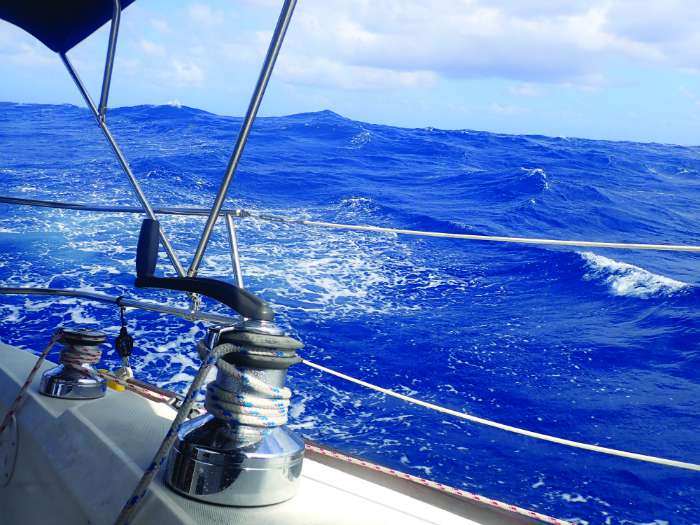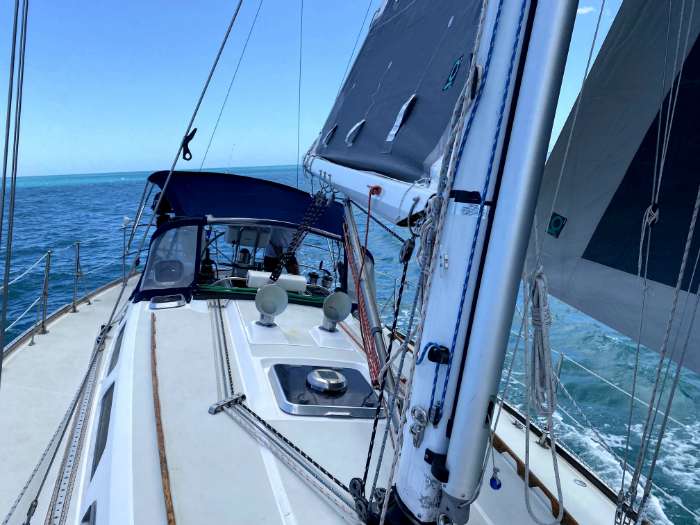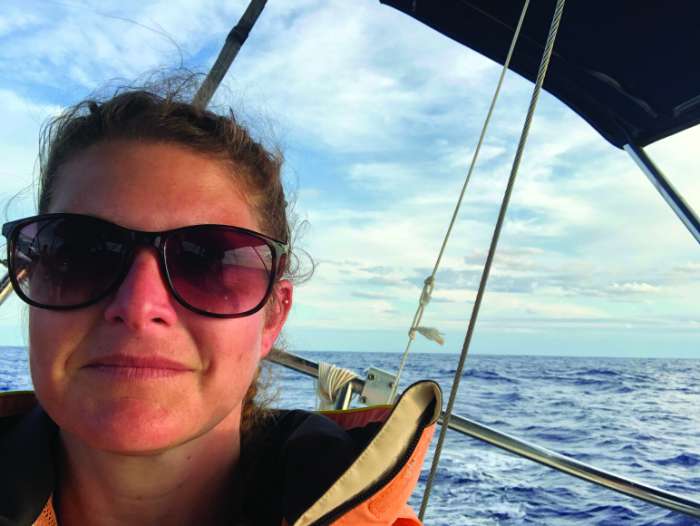Sweat, Tears, and the Sea—A Salty Love Story for Sailors
It was a beautiful sailing morning; the breeze was warm and the sunrise washed the ocean with shades of peach and lavender. Nick relaxed at the helm, groggily sipping his coffee, while I put a pot of water on the stove to make Eggs Benedict. Mornings like this deserve a fancy breakfast, plus we really needed to use anything perishable before it spoiled. As I tried to find the butter in a refrigerator that had rearranged itself overnight, Nick headed to the bow with some heavy-duty tape to mend a severely chafed furling line.
We were 11 days into a transit from the West Coast of Puerto Rico to Baltimore aboard Pazuzu, our Sabre 402. This was our first offshore trip together and Poseidon had made sure it was going to be memorable.

To reach a port, you must set sail.
We cast off our lines the Monday after Easter. A high-pressure system had caused us to delay our departure, but the forecast looked favorable, and it was time to begin the 1400-nautical-mile voyage home. Our friends gathered on the dock and waved goodbye as we motored away from the marina that had been Pazuzu’s home for almost five months. The late afternoon sun sparkled on the turquoise Caribbean water as we raised sail, both of us excited for the adventure ahead.
The decision to delay our departure appeared to pay off as the wind steadily built into the evening, and despite a little initial queasiness, our first day had been textbook champagne sailing. We settled into our first overnight watch rotation. The breeze was hot on my cheek as I watched the lights on the island twinkle and grow smaller on the horizon as Pazuzu sailed into the night.
A soft beeping broke into my blissful thoughts and the boat began to sail off course. Nick quickly poked his head up through the companionway, awoken by the sound of luffing sails and the autopilot alarm. Some quick troubleshooting confirmed our fears: the autopilot had failed. With no way to repair it, we would have to hand steer the rest of the voyage.
If you can’t control the wind, adjust the sails.
A dead autopilot wouldn’t be the last surprise Poseidon had in store for us. A spirited second day of sailing led to several windless days of drifting with the seaweed, making homemade pizza and reading while we waited for the breeze to fill. On our seventh day at sea, the new alternator failed; now we couldn’t charge our batteries, run the fridge, or use the electric head. This also meant we had to make some conscious decisions about how often we used the chartplotter and AIS and even how often we could start the motor. Day eight delivered big wind and even bigger seas that forced us to uncomfortably heave-to until the next morning when the wind would hopefully be more manageable. As the morning of day nine dawned, the wind had calmed to a sailable 20 to 25 knots. After tucking a deep reef in the main and the genoa, I took the first watch. Nick went below to get some much-needed sleep.
We had lost a lot of ground overnight heaving-to, and I was anxious to get moving and make up some distance. The sea was still angry. Several waves reached the second spreader. To help calm my nerves, I made a game of climbing these monsters. If I got the angle right, Pazuzu slid effortlessly down the other side. If I didn’t, it felt like we sailed off the side of a cliff and crashed on the bottom on the next trough. By late afternoon, the wind was calm, and the sea had settled into glass. We decided we had enough battery charge to start the engine and motored through the moonless night, watching the bioluminescent algae kick up in our wake. I turned the helm over to Nick and went to sleep, hoping to wake up to the gently building southerly that was forecast. We were finally getting a bit of good luck!

A smooth sea never made a skilled sailor.
The wind shifted to the south just before sunrise and gentle rollers followed Pazuzu’s stern. We were running with only the genoa since the wind was forecast to build into the 20s with higher gusts possible. Late morning the breeze built, and so did the following seas. We were seeing a steady 25-plus knots, already more than forecast. We furled in most of the genoa, put on our foulies, and clipped in. Nick noticed the furling line had chafed through to the core. This was not the time to make a proper fix. Some heavy-duty tape would have to do. Hopefully it wouldn’t break!
By early afternoon the waves had grown into a mountainous landscape behind us, and there was a heavy, monsoon rain. The rain drops hit with such force, they hurt. Water got in every seam of our foulies. We had been taking one-hour shifts at the helm since noon, and neither of us had eaten. It was late afternoon, and I was almost through my watch when the wind and rain suddenly lightened. The waves behind us smoothed. There was an eerie calm. Five minutes later, the squall hit.
The rain was so heavy that we couldn’t see past the dodger. We saw wind speed of 58 knots before the instruments were swallowed by the rain. Minutes felt like hours. An alarm sounded. My watch was up, but there was no leaving the helm now. I turned the bow down and ran. Everything was so loud. A pillow in the cockpit levitated, spun, and flew out of the boat. Nick looked at me and shouted, “I love you!” The world went silent. It was as if Poseidon flicked a switch, and the wind and rain turned off. Everything was still. For a moment, we relaxed. Minutes passed and flick! The wind and rain machine was back on. We continued through the night with 25- to 30-knot wind and heavy rain. The rain eventually stopped. The wind clocked north, and the lightning storm started. The hour shifts became 30 minutes as exhaustion and fear took over. It was hard to imagine that this would ever end.

As the blur of the night went on, the red glow of the instrument panel was slowly replaced by the soft, hesitant rays of the sun. The morning had finally come and had brought with it calmer seas, softer breeze, and a renewed appreciation of the awesome power of nature. We had made it!
With each golden tendril of light that spread over our bow, my exhaustion and fear gave way to a bigger feeling: love. After all the sweat and the tears, my love was still for the sea and sailing and above all, for Nick. I turned over the helm and went down to the galley to start some coffee. Mornings like this deserve a fancy breakfast!
Lessons Learned:
Carry spare parts for essential systems (and make sure they work before you leave dock!).
It’s always safer to reduce sail before you need to. You can always shake out a reef if you don’t need it, but it’s much harder to put in a reef in a gale.
Communication is key. Talk through maneuvers before and while you do them and wait for confirmation from the crew before continuing to the next step.
Of all the gear, spare parts, and whatever other equipment you could bring on an ocean crossing, the most important is sailing with a person you trust; someone who has sailing experience, who can handle the boat and help in the decision making when things get rough, especially for double-handed crossings.
~by Jessica Morrison
Find more sailing safety tips here.




